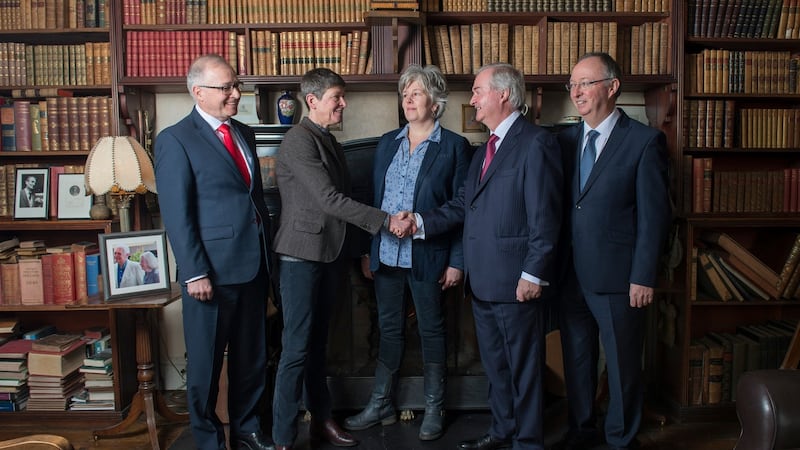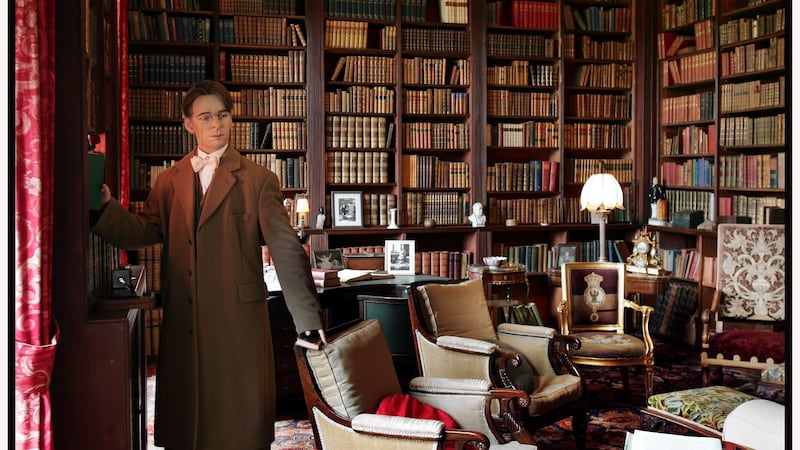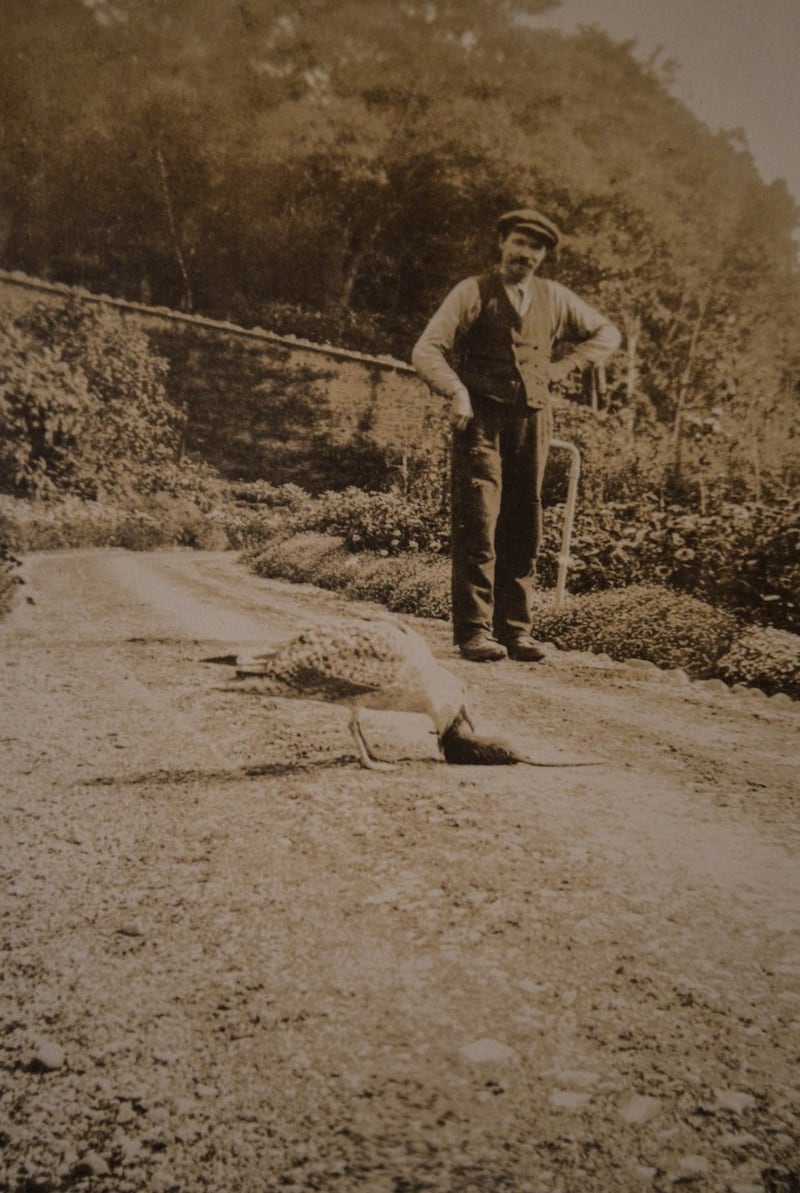On the last day of January, at the historic Westport House, in Co Mayo, there was a press conference to announce the surprise news that, almost a year after the house and its grounds had gone on sale, they had been bought. The sellers, the sisters Sheelyn and Karen Browne, were photographed standing between the new owners, the brothers Owen, Cathal and Harry Hughes. Sheelyn Browne is shaking hands with Cathal Hughes.
The Browne family, whose history with the house and estate goes back to 1730, had only the previous day learned of both the sale and the identity of the buyers. It clearly took considerable courage and grace for the sisters to stand in the public eye that morning. They had to greet the new owners – who run the international Portwest clothing company – with civility, knowing that the sale was an end to the financial nightmare the family had been enduring for years, while processing the fact that this was the end of their centuries-long link to the house and estate.

Westport House was never only bricks and mortar to the Browne family; it was part of their identity. And if the estate was personal history to the Brownes, its influence on the town that lies at its borders has been evident for centuries.
Westport is a planned town, built in the late 18th century as a place for estate workers and tenants to live. So when the estate ran into serious financial difficulties, in 2015, Westport’s residents were transfixed.
Multimillion-euro loan In 2006
the late Lord Altamont, Jeremy Browne, borrowed €6.5 million, secured on 380 acres of the 455-acre estate. As his daughter Sheelyn told The Irish Times in 2015:
We reached this crossroads – another one, as there had been many – and my father felt there were three choices: to sell up, keep going the way we were, or invest further.
This was just a year before the economic downturn, and he took a loan and created a masterplan, a 50-year strategy, which was really requested by Mayo County Council.”
Drawings for proposed developments on the estate were commissioned from RKD Architects, drawings that included shops, a hotel and housing. The project got no further. Over time the debt on the loan steadily grew to €10 million. It remains unclear what the original loan of €6.5 million was spent on. The Westport House roof was replaced in 2011, funded by a State grant of €1.6 million from the Heritage Council.
By 2015 the debt was unserviceable, and it went into the National Asset Management Agency, the organisation set up to manage bad bank loans. For a time it seemed as if the loans linked to land at Westport House would be included in the Project Arrow portfolio that Nama was selling. It was feared that this collection of debts would be bought by the US fund Cerberus – formally called a global investment company, and colloquially known as a vulture fund – and, with it, the future of Westport House.
A public meeting was held at Westport Town Hall in October 2015 to discuss the uncertainty surrounding the estate. The 225-seat venue was packed, with many people having to stand. As one local puts it this week,
To think of Westport without the house was like thinking of Mayo without Croagh Patrick.
The biggest fear was that the estate would be bought by outsiders as an expensive private folly, with gates closed and locals shut out. There were rumours of Chinese buyers. The hope was that the State would buy it, but, according to Mayo County Council's chief executive, Peter Hynes, this was never a realistic option. "I can only speak from a local-government viewpoint," he says. "We're good at many things, but managing historic estates is not really one of them."
After the public meeting, and following negotiations with the council, Nama withdrew the loans secured on Westport House from the Project Arrow portfolio. In January last year it went on the open market for €10 million. Then there was silence.
The Brownes have not lived in the 33-room house, which was designed by Richard Cassels, since 1961. That year it opened to the public, and the family retreated to another house on the estate.
Westport House is closed until February 18th, but Biddy Hughes, its marketing manager, gives me a tour. Even my unprofessional eye can see at once that, beautiful as the house remains, damp is now evident, especially on the upper floors. Paint is peeling in many places, and the heating system is primarily based on open fires. After the Browne family moved out, one person put it to me that,
It wasn't a house any more, it was a museum.
Lord Altamont commissioned a series of waxworks for the house, featuring people in the arts who were once prominent in the locality. The blind harpist Turlough Carolan, Lady Gregory, WB Yeats and several others are all now gathered in one upstairs room – an eerie, unsettling substitute for the living, breathing people who once occupied the big house.
House and town
The people I speak to in Westport are almost uniformly relieved that the estate has new local owners, although they also expressing empathy with the Brownes over the transition. Several locals use the expression “house and town” when they talk about the estate. They don’t quite say “them and us”, but the cultural implication of centuries of a distinct separation is there just the same.

The Brownes were good landlords during the Famine, which is remembered with gratitude to this day, but 1922 changed things for every landed Anglo-Irish family in Ireland. It seems to be commonly accepted in the town that the all-time low in relations between house and town occurred in the 1950s.
The town council decided to issue a compulsory purchase order for a highly significant part of the front lawn of the house, which included what was then the entrance driveway. The purchase was driven by a local *councillor, the late Owen Hughes, who wanted the council to buy the land for social housing. It was common knowledge in the town that the Brownes opposed the purchase, believing that it ruined the integrity of the estate. Nevertheless, the motion was passed.
“It was really the nationalists saying ‘Up yours’ to the Brits,” according to one public figure in the town.
In 1981 Denis Browne, the 10th marquess of Sligo, published Westport House and the Brownes. He referred bitterly to the issue. "That this would ruin the unique physical relationship between house and town was hardly considered," he wrote. The monetary compensation from the council had been "derisory", he added, and the impact of the purchase was "a classic case of modern vandalism".

A social-housing estate was built on the land, as was a textile factory. A second factory was to open, to be an ancillary dyeing operation. In time the original factory was sold; a Lidl store now stands on the site. The local health board also built offices on the land.
The second factory was never built. That site is now where the 129-room Hotel Westport stands, one of three hotels in the town run by the Hughes brothers.
Direct access to the house from the town had now been closed, and people had to go the long way, down the quays, instead. It made the division between house and town even more pronounced.
It was not until 2013 that new gates to the estate were opened, on Church Lane, at the back of the Wyatt Hotel. It was the first time in 60 years that Westport House could be accessed directly from the town.
In October 2013 the Westport town manager at the time, Martin Keating, spoke at the official opening of the gates. For such a formal occasion his speech was unusually personal and moving, recognising the symbolism of once more opening up the space between the house and town.
Keating referrred to "atonement on behalf of Westport Town Council for decisions of the past". Speaking of the council's compulsory purchase of the land in the 1950s, he said: "In the fervency of national sentiment, young political dynasties were keen to assert their newfound dominance on an old order. This often led to rash and short-sighted political gain, tempered in the fires of nationalism . . .
The decision to acquire the front lawn of Westport House was a decision that ultimately severed the house's direct relationship to its town, both physically and psychologically.
Keating spoke of “co-operation and healing” and of decisions made in the past that belonged “to a different Ireland of yesteryear”.
Only two years later the same townspeople who had gathered for that speech were to be found in the town hall, at the public meeting to offer their support to the Browne family, whose historic estate was now partially in Nama.
The Browne sisters did not take up an inviation to be interviewed for this article.
Negotiations
After months of what we now know were private negotiations between Mayo County Council, the estate’s administrators, and possible buyers, the uncertainty about the future of the estate ended on January 31st.
Mayo County Council is in the process of buying 40 acres of land for €2.1 million.
“To be completely accurate, we are buying the Nama loan, because the paperwork is still going through. The new purchasers redeemed the loan from us,” Peter Hynes says. The land the council is in the process of buying is for mixed use, Hynes says: “social housing, some economic development and some possible amenities.”
The Hughes brothers have bought the house and 415 acres of the estate. They are thought to have paid about €10 million; the exact price paid for the house itself will appear in the national property price register in due course.

Hynes is understandably positive about the brothers’ purchase and their plans for development. “We met with other potential purchasers over the months, including the Hugheses,” he says. “You can never tell what is going to happen in the future, but I have very few concerns that the Hughes family won’t continue the legacy of Westport House long into the future.”
With their successful clothing company Portwest (which had a turnover of €103 million in the year to the end of Feb 2016), Carraid Donn and three hotels, the brothers are key employers in the town.
“Initially it arose that we were landlocked with developing Hotel Westport further, and that brought me into a discussion with Sheelyn Browne,” says Cathal Hughes. “And, following that discussion, myself and my two brothers looked at the possibility of buying the house and the estate.”
Five-year plan
The Hugheses estimate that their five-year plan to develop the estate will bring 200 construction jobs to the town.
“In the immediate future, the next 18 months, we want to try and do work in the house so it could be suitable for more coach tours and for wedding receptions and other functions,” says Cathal Hughes. “As the house stands now there is no heating, and no access for people with disabilities, and that has got to be addressed immediately.”
In the longer term the brothers want to connect the Westport Hotel with the wider estate by building a conference centre, self-catering apartments, shops and restaurants. They also hope to open a Gráinne Mhaol interpretive centre on the site. Hughes says
Our aim is to eventually finish Westport House to a standard that people would want to visit it as a destination
It is an irony that has not gone unrecognised in the town that the Hughes brothers are the nephews of the late councillor Owen Hughes who advocated the purchase of the front lawn in the 1950s.
“I think when the 26 counties got its freedom from England,” Cathal Hughes says, “that one of the agreements was that no estate would be breached. And I think I am correct in stating that that was the first estate that was breached in Ireland in the 1950s, under a CPO”, or compulsory purchase order.
“I’m sure people had opinions about the CPO at the time, but that’s history. We can’t influence what went on in the past, but we can certainly influence what goes on in the future in relation to Westport House and Hotel Westport.”
*This article was ammended on Jan 11th 2017 to remove Fianna Fail from the title of the late councillor Owen Hughes.










